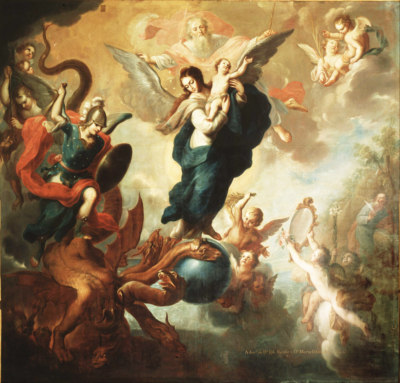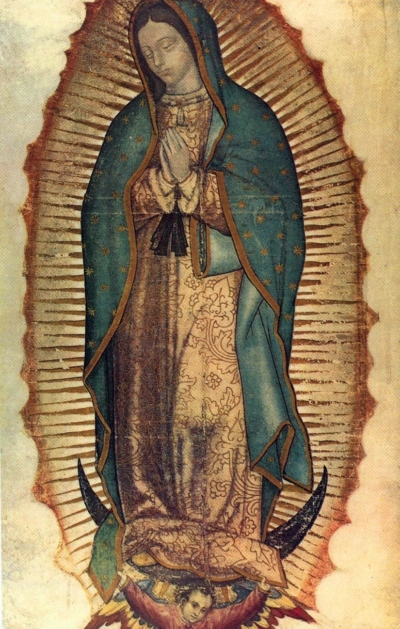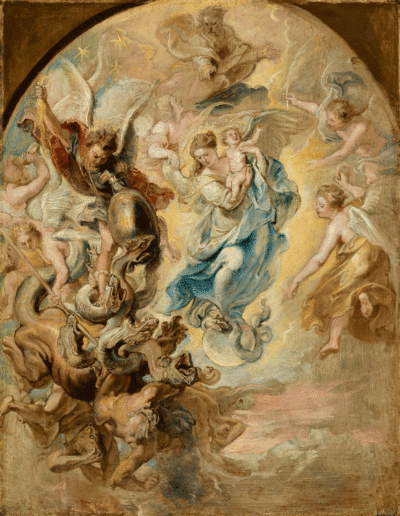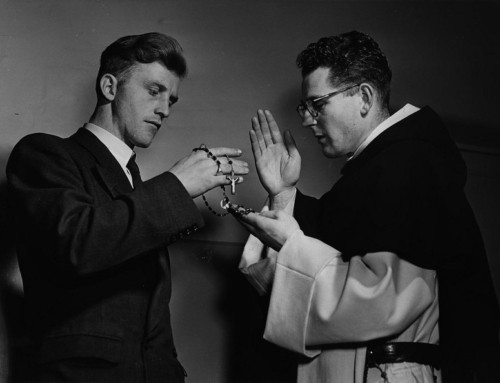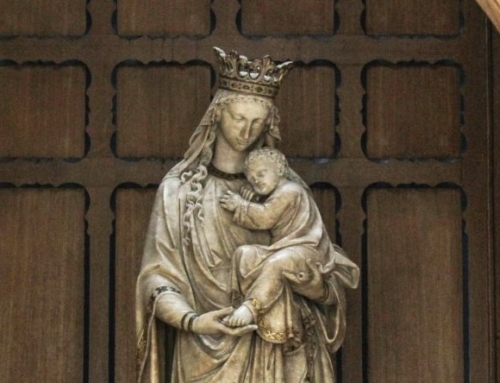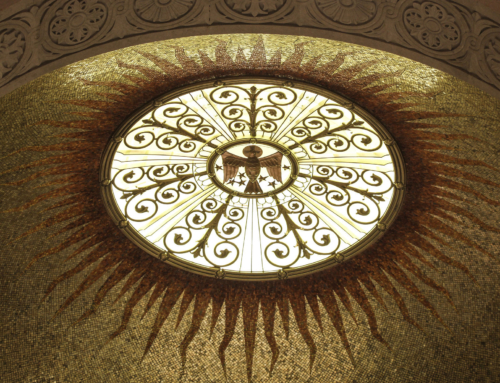Revelation 12: And a great sign appeared in heaven . . .
This sign demands a response from the assembly of angels, assent or dissent, obedience or disobedience. The trial of the obscurity of faith presupposes, as in the case of any rational creature, an intellect and a will. With splendid knowledge of God, incomparably greater than that of man, the angels understand the gravitas of the sign: God has ordained that the supernatural order would supplant the natural order. That a certain economy of grace would elevate creation. That beatitude, or heaven, would only be attained by self-renunciation—the Cross.
. . . a woman clothed with the sun, with the moon under her feet, and on her head a crown of twelve stars . . .
The assembly marvels at the image of the woman. She is the chosen vessel and precious portal: the Mother of God. For the angels, the great sign—a sign of contradiction—is the mystery of the Incarnation. The angels recognize in this sign the eternal will of the Father: to unite all things in the person of his Son, the Incarnate Word of God. Called to be ministers and collaborators in this plan of salvation, the angels are given a choice, with the consequences being irrevocable: to serve the child—the God-Man—or not.
. . . and another sign appeared in heaven; behold, a great red dragon, with seven heads and ten horns, and seven diadems upon his heads . . .
Lucifer, a seraph angel according to the natural order, manifests his perverse will to the assembly. Scandalized by the Incarnation and the supposed elevation of the woman by grace, he attempts to determine for himself—apart from God—the good of his existence. First poisoned by the sin of pride, envy immediately takes hold of Satan, and he expresses contempt for the woman and the child.
. . . now war arose in heaven, Michael and his angels fighting against the dragon; and the dragon and his angels fought . . .
The war of time immemorial begins with disobedience: a rebellion, instigated by the adversary of mankind, which continues even now. The prince of the heavenly hosts, having discerned the non serviam of Lucifer, rallies the angelic choirs together, wielding sword and shield against the enemy, commanding his army to cast the beast out, forever. The seraph falls sharply, his appearance marred by the ugliness of sin; he has chosen against the providential designs of his Creator, spurned the delights of God, because of a woman and her child.
Miguel Cabrera — The Virgin of the Apocalypse
As the angelic war ensues, the arresting image of the woman, clothed with the sun, with the moon under her feet, and on her head a crown of twelve stars, remains. The woman strikes, as it were, the head of the beast, holding—perhaps, protecting—the child as the belligerent dragon falls. Is the woman shielding her son from the gruesome scene happening underfoot? Or, better yet, is the child anticipating the flight away from the battle, for which purpose the two wings were given to his mother? Neither the woman nor the child express fear. The child gazes longingly at his Father. The woman smiles knowingly.
Miguel Cabrera’s The Virgin of the Apocalypse (1760) excites with its lively energy; its brilliance compares favorably with the accomplishments of the great Italian Renaissance master, Michelangelo, whose work Cabrera emulated and esteemed as art par excellence. In both fame and genius, Michelangelo and Cabrera were kindred spirits: Michelangelo in Italy, Cabrera in Mexico. Like the assorted biblical scenes which cover the walls and ceiling of the Sistine Chapel, The Virgin of the Apocalypse chronicles a dramatic event recounted in the last book of the Bible, the Apocalypse of the Apostle John (or simply, the Book of the Apocalypse).
Cabrera’s oil painting of the twelfth chapter from the Book of the Apocalypse depicts, in sensational fashion, the momentous role of the woman in the economy of salvation. During the first centuries of Christendom, the Church Fathers generally understood the woman of the Apocalypse as a figure of the Church; in fact, not until the medieval period did the woman become more commonly associated with the Blessed Virgin. By the eighteenth century, however, artists of the baroque period universally interpreted the woman of the Apocalypse as Our Lady. Undoubtedly, the Catholic Reformation (responding to the sixteenth-century Protestant Reformation) influenced this development and likewise engendered Marian piety and devotion among the faithful. For the post-Tridentine Church, art became one of the foremost instruments of evangelization, intent on revealing the order, unity, and clarity—in a word, beauty—found in the saving truths of Scripture and Tradition.
The Virgin of the Apocalypse, then, as was customary of the time, conveys immense meaning and forethought by the artisan; every facet of the piece, every shade of color, every contour or expression of the face, every detail, exudes intentionality, in order to express the natural beauty and goodness reflected in creation. The objective of such painters, sculptors, and other craftsman, the underlying goal for the period, was to inculcate a sense of awe for the grandeur of reality, which for the devout of heart also entailed the elevation of nature by grace. By accentuating emotion and drama in their principal characters, baroque pieces have exceptional qualities of realism, a realism which presupposes a God at work in and among his creation. As a result, the most minute of details has the capacity to arrest the imagination.
The Virgin of Guadalupe
Cabrera’s composition is even more striking when considered alongside another image which portrays the woman from the Book of the Apocalypse: the celestial Virgin of Guadalupe. This miraculous and familiar icon of Our Lady, impressed upon the tilma of St. Juan Diego Cuauhtlatoatzin (1474–1548), is held especially dear to the Mexican peoples and renowned throughout the world. The tilma never ceases to beguile the most skeptical mind, if only for its unusual durability and lack of pigmentation. Where The Virgin of the Apocalypse dazzles us with its splendor and elevation of the natural to the supernatural, the Virgin of Guadalupe captivates us by its otherness, by which it transmits the supernatural through the miraculous use of natural materials. The apparitions and messages of Our Lady of Guadalupe, similar to the milieu associated with the baroque period, emphasize the beauty and goodness of God found in creation, while also revealing something about its promised elevation. The Immaculate Virgin Mary, the very garden of God, is the most perfect reflection of this beauty and goodness.
The relationship between The Virgin of the Apocalypse and the Virgin of Guadalupe also concerns the painter, Miguel Cabrera. In 1752, the artist was granted unprecedented access to the miraculous icon in order to fashion three copies: the first, for the Archbishop of Mexico City; the second, for the Holy Father; and the third, for the purpose of further replication. This project preceded the completion of The Virgin of the Apocalypse; so Cabrera, who knew of the apocalyptic undertones at Guadalupe ( . . . a woman clothed with the sun, with the moon under her feet . . . ), painted his piece having previously studied the image of the Virgin of Guadalupe for years.
Peter Paul Rubens — The Woman of the Apocalypse
Also of note, Cabrera “borrowed” the format and iconography of his work from the Flemish painter, Peter Paul Rubens, who completed a painting on the same subject sometime between 1623–1625. While Cabrera’s masterpiece exceeds Rubens’s in terms of prominence today, the original, if you will, enjoyed extraordinary popularity in the seventeenth century. Rubens’s art traversed the seas, arriving in the Spanish Americas for men like Cabrera to “borrow” and reproduce. And yet, Cabrera did not simply duplicate Rubens’s The Woman of the Apocalypse as he did with the Virgin of Guadalupe. Instead, though he followed the format and overall iconography of Rubens, he incorporated elements from the Virgin of Guadalupe, which surely derived from his personal piety and his intimate knowledge of the miraculous icon.
Apart from the notable differences in style, Cabrera differed from his Flemish precursor in subtle ways. For example, Cabrera incorporated tacit details of Marian iconography particular to the Immaculate Conception. Where in some reproductions of Rubens’s piece the garments of Our Lady are colored red and blue, Cabrera chose the pigments typically associated with the Immaculate Conception, that is to say, white and blue. The humble demeanor of the woman, despite the chaos which seemingly surrounds her, also lends itself to the pleasant posture characteristic of Mary Immaculate. On the right of the woman and child, cherub angels brandish instruments which evoke titles of the Blessed Virgin from the Litany of Loreto: speculum justitiae, mirror of justice; rosa mystica, mystical rose. Finally, Cabrera followed the woman’s expression as imprinted upon the tilma: eyes cast downwards, a smile adorning her face. Rubens’s Virgin, in contrast, possesses a severe countenance, far removed from any sense of benevolence.
Specific to the Virgin of Guadalupe, however, Cabrera accomplished something extraordinarily beautiful in The Woman of the Apocalypse; alas, the idea is elusive to the casual observer, having been overwhelmed by the vast movement and drama of the piece. The woman depicted in Cabrera’s painting is Our Lady of Guadalupe. While The Woman of the Apocalypse and the Virgin of Guadalupe both depict the same woman from the twelfth chapter in the Book of the Apocalypse, Cabrera—the preeminent artist of Mexico—portrayed Our Lady so that his people, to whom and for whom the Blessed Virgin appeared, would recognize, first and foremost, the Virgin of Guadalupe. In essence, Cabrera identified the woman of the Apocalypse as the Virgin who appeared to the Mexican peoples; this woman definitively revealed herself as the Apocalyptic Virgin of Guadalupe. She is the great sign of contradiction, who even now, intercedes for her beloved children.
The message of Our Lady of Guadalupe bequeathed to St. Juan Diego in 1531 also suggests this definitive reading. During the first of five successive apparitions that occurred over the course of four days, the Blessed Virgin introduced herself by way of identification:
I am the perfect and ever virgin Holy Mary, Mother of the God of truth through whom everything lives, the Lord of all things near us, the Lord of heaven and earth.
She then declared the purpose of her apparition:
I want very much to have a little house built here for me, in which I will show him [God], I will exalt him and make him manifest.
I will give him to the people in all my personal love, in my compassion, in my help, in my protection: because I am truly your merciful Mother, yours and all the people who live united in this land and of all other people of different ancestries, my lovers, who love me, those who seek me, those who trust in me. Here I will hear their weeping, their complaints and heal all their sorrows, hardships and sufferings.
(A Handbook on Guadalupe, 1997)
Tradition holds that when St. Juan Diego asked the Blessed Mother for her name she responded, in his native language of Nahuatl, “Tlecuatlecupe,” which means “the one who crushes the head of the serpent.” For Christians, the allusion to the serpent is generally acknowledged as a reference to Satan, the adversary of mankind. For Mexicans, especially those with ancestors who practiced the Mesoamerican religions of the Aztec peoples, it may also refer to the feathered serpent god, Quetzalcoatl, thereby serving a dual allusion. Our Lady crushes the head of Satan and the head of the pagan religions. At the far right of the scene, St. John the Theologian is painted as the lone witness of the drama, true to the reputable tradition that the evangelist composed the Book of the Apocalypse on the island of Patmos. Mexican commentators, in the centuries following Our Lady’s appearance, did not fail to recognize the evident connection between the two men with identical names, St. John and St. Juan, both of whom had visions of the same woman. Notice, as well, the waters which separate the woman and the island of Patmos, symbolizing the journey of the Christian faith to the shores of Mexico.
For all their similarities, there is one striking contrast regarding the woman in the two images. Our Lady of Guadalupe is noticeably pregnant, whereas Cabrera’s rendering depicts a woman holding a male child. The presence of the child in The Woman of the Apocalypse represents the fulfillment of the promise hidden in the miraculous icon of the Virgin of Guadalupe: that the woman would give birth to a son, the Incarnate Word of God, in the hitherto pagan land. And indeed, the Virgin of Guadalupe, the great sign of contradiction and the woman of the Apocalypse,
. . . brought forth a male child, one who is to rule all the nations with a rod of iron. . . .
Now we, the sons and daughters of Adam, stand in the arena, fighting the “good fight of faith” and running “so as to win,” preparing ourselves for the day we will stand on trial (1 Tm 6:12, 1 Cor 9:24). Meanwhile, the child gazes at his Father, awaiting the day and hour of his Second Coming. The woman smiles upon us from the heavens; the angels sing her praises.
✠
Download a PDF of this article here.

